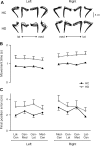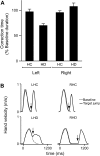Hemispheric specialization for movement control produces dissociable differences in online corrections after stroke
- PMID: 21878488
- PMCID: PMC3357180
- DOI: 10.1093/cercor/bhr237
Hemispheric specialization for movement control produces dissociable differences in online corrections after stroke
Abstract
In this study, we examine whether corrections made during an ongoing movement are differentially affected by left hemisphere damage (LHD) and right hemisphere damage (RHD). Our hypothesis of motor lateralization proposes that control mechanisms specialized to the right hemisphere rely largely on online processes, while the left hemisphere primarily utilizes predictive mechanisms to specify optimal coordination patterns. We therefore predict that RHD, but not LHD, should impair online correction when task goals are unexpectedly changed. Fourteen stroke subjects (7 LHD, 7 RHD) and 14 healthy controls reached to 1 of the 3 targets that unexpectedly "jumped" during movement onset. RHD subjects showed a considerable delay in initiating the corrective response relative to controls and LHD subjects. However, both stroke groups made large final position errors on the target jump trials. Position deficits following LHD were associated with poor intersegmental coordination, while RHD subjects had difficulty terminating their movements appropriately. These findings confirm that RHD, but not LHD, produces a deficit in the timing of online corrections and also indicate that both stroke groups show position deficits that are related to the specialization of their damaged hemisphere. Further research is needed to identify specific neural circuits within each hemisphere critical for these processes.
Figures






References
-
- Alexander GE, Crutcher MD. Preparation for movement: neural representations of intended direction in three motor areas of the monkey. J Neurophysiol. 1990;64:133–150. - PubMed
-
- Allred RP, Jones TA. Unilateral ischemic sensorimotor cortical damage in female rats: forelimb behavioral effects and dendritic structural plasticity in the contralateral homotopic cortex. Exp Neurol. 2004;190:433–445. - PubMed
Publication types
MeSH terms
Grants and funding
LinkOut - more resources
Full Text Sources
Medical

